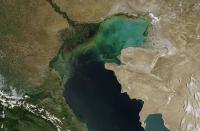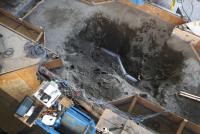-
NSF announces $55 million toward national research priorities
The National Science Foundation (NSF) has made eleven awards totaling $55 million aimed at building research capacity to address fundamental questions about the brain and develop new innovations at the intersection of food, energy, and water systems. These four-year awards support twenty-seven institutions in eighteen eligible jurisdictions.
-
-
Reactor safety experts from Sandia help industry learn from Fukushima accident
Reactor safety experts from Sandia National Laboratories and elsewhere are sharing lessons learned in Japan’s Fukushima Daiichi nuclear accident and other severe accidents that pushed nuclear power plants past their limits. The safety experts seek to demystify what happens during an accident, to help engineers/operators learn what decisions they might need to make in the event of an accident at their plants, and to provide insights into the non-intuitive nature of accidents.
-
-
Economic growth will not counterbalance increasing climate change-related damage
More than 50 percent of all weather-related economic losses on the globe are caused by damages due to tropical cyclones. New research finds that financial losses per hurricane could triple by the end of the century in unmitigated climate change, while annual losses could on average rise by a factor of eight. The researchers also concluded that economic growth will not be able to counterbalance the increase in damage.
-
-
How a new source of water is helping reduce conflict in the Middle East
Just a few years ago, in the depths of its worst drought in at least 900 years, Israel was running out of water. Now it has a surplus. This remarkable turnaround was helped by increasing conservation and re-use – but the biggest impact came from a new wave of desalination plants. Israel now gets 55 percent of its domestic water from desalination. Moreover, scientists and others look to desalination as a way to unite longtime enemies in a common cause.
-
-
Six million Americans drink water with unsafe levels of toxic chemicals
Levels of a widely used class of industrial chemicals linked with cancer and other health problems exceed federally recommended safety levels in public drinking water supplies for six million people in the United States, according to a new study.
-
-
Seawalls, coastal forests in Japan help reduce tsunami damage
Researchers who analyzed a history of tsunamis along the Pacific coast of Japan’s Tohoku region have learned that seawalls higher than five meters reduce damage and death, while coastal forests also play an important role in protecting the public. Japan has embarked on a 10-year reconstruction project costing about 31.5 trillion yen, or about $255 billion, which includes the construction of tsunami seawalls along Tohoku’s Pacific coast. Critics of the program have voiced skepticism about the effectiveness of seawalls.
-
-
Brazil’s sewage woes reflect the growing global water quality crisis

All eyes are turned toward Rio de Janeiro to watch top athletes compete, yet the headlines continue to highlight the problems with the water quality and the risks to the athletes who swim, row, and sail, and even to tourists simply visiting the beaches. But Brazil’s wastewater woes are hardly unique. The water quality of lakes, rivers, and coastal shorelines around the world is degrading at an alarming rate. In fact, pollution of the ten largest rivers on earth is so significant that it affects five billion people. While the spotlight is shining on the athletes over the next few weeks, let us also shine a spotlight on what we can do to improve and restore water quality around the world through our collective efforts, use of new tools, and risk frameworks, moving the political will one step closer toward sewage treatment and protection of the biohealth of the blue planet.
-
-
Belarus’s lax approach to nuclear safety raises fear of another Chernobyl

Thirty years after Chernobyl, the world’s worst nuclear accident, a series of mishaps at a nuclear facility in Astravets, in Belarus, has raised concerns over nuclear safety, especially in neighboring Lithuania. Vilnius, the country’s capital, is located less than thirty-one miles from Astravets. Lithuania, accusing Belrus of Soviet era-like lack of transparency, says it would work with the international community to block the Astravets plant coming online.
-
-
Build disaster-proof homes before storms strike, not afterward
There are many technologies we can use to make our buildings more hazard-resistant. But we are not using them as extensively as we should. Instead of designing a building to reduce potential damage from the hazards it may face over its lifetime, most construction projects focus on saving money up front. By choosing the lowest construction cost possible, homeowners, insurance agencies, and taxpayers may end up paying for it many times over when natural disasters occur. To prevent the devastation from another storm, twister, or quake, we need to make deep investments nationwide in mitigation now, before the next disaster strikes.
-
-
Trading farmland to protect water from nitrogen

Excess nitrogen from agricultural runoff can enter surface waters with devastating effects. Algal blooms and fish kills are a just a couple of possible consequences. But riparian buffer zones – areas of grasses, perennials, or trees – between farmlands and streams or rivers can help. But what kind of vegetation makes buffer zones most efficient at removing nitrogen from runoff? A new study sets out to answer.
-
-
How to generate energy during earthquakes
Physics students from the University of Leicester have explored a feasible way to harness the power of earthquakes during a disaster in order to keep vital systems powered. By using a magnet inside a coil during the shaking of tectonic plates that occurs during an earthquake, the students suggest that the magnetic field created by the shaking could generate a current which could potentially be harnessed.
-
-
Climate risk and the fossil fuel industry
Burning coal, oil, and natural gas is responsible for two-thirds of the world’s greenhouse gas emissions. Yet these same fuels are also the economic mainstay of resource-rich countries and the world’s largest companies. According to a new study, this means that climate-change relief actions represent danger for the fossil fuel business.
-
-
Fort Collins, Colorado, using NIST guide to bolster community resilience
Guided in part by strategies and procedures developed by NIST for creating effective and affordable community resilience, the city of Fort Collins, Colorado, is making a commitment to “deal with prospects of future weather- and climate-related challenges that put our community at greater risk,” according to Mayor Pro Tem Gerry Horak.
-
-
Electric grid vulnerabilities in extreme weather areas
Climate and energy scientists at the DoE’s Oak Ridge National Laboratory have developed a new method to pinpoint which electrical service areas will be most vulnerable as populations grow and temperatures rise. The scientists’ integrated approach – combining ORNL’s unique infrastructure and population datasets with high-resolution climate simulations run on the lab’s Titan supercomputer — identifies substations at the neighborhood level and determines their ability to handle additional demand based on predicted changes in climate and population.
-
-
Earthquake-resilient pipeline could allow Los Angeles’s water utility system withstand tremors

Los Angeles’s water utility system – the nation’s largest — crosses over thirty fault lines en route to supplying water to more than four million residents. A top engineer from the city of Los Angeles visited Cornell University this month as researchers tested a new earthquake-resilient pipeline designed better to protect southern California’s water utility network from natural disasters. The steel pipe uses a unique structural wave design to control buckling, allowing the pipe to bend and compress without rupturing or losing water pressure.
-
- All
- Regional
- Water
- Biometrics
- Borders/Immig
- Business
- Cybersecurity
- Detection
- Disasters
- Government
- Infrastructure
- International
- Public health
- Public Safety
- Communication interoperabillity
- Emergency services
- Emergency medical services
- Fire
- First response
- IEDs
- Law Enforcement
- Law Enforcement Technology
- Military technology
- Nonlethal weapons
- Nuclear weapons
- Personal protection equipment
- Police
- Notification /alert systems
- Situational awareness
- Weapons systems
- Sci-Tech
- Sector Reports
- Surveillance
- Transportation
Advertising & Marketing: advertise@newswirepubs.com
Editorial: editor@newswirepubs.com
General: info@newswirepubs.com
2010-2011 © News Wire Publications, LLC News Wire Publications, LLC
220 Old Country Road | Suite 200 | Mineola | New York | 11501
Permissions and Policies
Editorial: editor@newswirepubs.com
General: info@newswirepubs.com
2010-2011 © News Wire Publications, LLC News Wire Publications, LLC
220 Old Country Road | Suite 200 | Mineola | New York | 11501
Permissions and Policies
